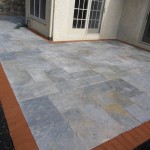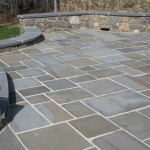 In earlier articles, we have discussed the basics of Pennsylvania Bluestone flagstone, its shapes, textures and colors. If you have read these articles or even simply reviewed a portfolio of pictures, you have a good feel for this wonderful natural stone. These factors, plus the process of installation are both important to its final appearance. Thickness is a key factor in installation options.
In earlier articles, we have discussed the basics of Pennsylvania Bluestone flagstone, its shapes, textures and colors. If you have read these articles or even simply reviewed a portfolio of pictures, you have a good feel for this wonderful natural stone. These factors, plus the process of installation are both important to its final appearance. Thickness is a key factor in installation options.
Two primary installation options exist for bluestone flagstone: dry and wet setting. Dry setting means installing over a compacted stone sub-base and a screeded stone dust setting bed with a flexible finishing joint material. Wet setting means installing over a concrete base on a mortar bed with a solid finishing joint material. Examples of flexible finishing joint materials include stone dust (aka screenings), polymeric stone dust, decorative stone, and topsoil. The most typical solid finishing material is mortar.
Natural clef pattern and irregular flagstone are available in two major thicknesses: 1” and 1 ½”. Because the thickness of these products results from natural separation along fault lines, the thickness is neither consistent nor exact. The thickness of one piece will vary across the length and breadth of the piece. If the thickness is generally between ½” and 1 ¼”, the flagstone is considered 1” flagstone. If the thickness is over 1 ¼”, it is generally considered 1 ½”. When flagstone is particularly thin, i.e., ½” or less, it is separated out at ½” flagstone. Some quarries will separate flagstone that is 3” or over into “heavy” flagstone. The extra thin and extra thick material are frequently included in 1” and 1 ½” categories.
For dry setting application, you will need 1 ½” material. This thickness is required to provide enough strength to handle minor shifts in the base and setting bed caused by geological and weather conditions. The wet setting application, you will want 1” material. This thickness has less variation within and between pieces making it easier to compensate for those differences in the mortar base. 
Thermal flagstone is cut to a nearly exact thickness, usually 1” or 1 ½”. For dry setting, use 1 ½”. For wet setting, either thickness is acceptable as there is no variation in thickness to be absorbed in the mortar bed.
If you use 1” bluestone flagstone in a dry set project, you risk having the material crack or break over time. If you are doing the project yourself and wish to avoid the weight of 1 ½” material, you can accept this risk and replace broken pieces later as necessary. If you have a professional contractor installing your project, make sure 1 ½” material is used.


Hello,
How much would 100 sq ft of thermal blue blue/gray select pennsylvania select 1″ rectangular tiles cost to deliver to Gainesville, FL?
Thank you,
Danny De Jesus
804-878-7032
I am looking to use 1″ thick thermal blue stone flags inside a 2″ thick blue stone border. This is a front stoop and has a poured concrete structure. I allowed for a 1″ mortar setting base for the borders. I want to set the infill flag stones as tight as possible with no mortar joints. is this advisable as i will have the flag installed on a mortar setting bed of about 2″ thick. Everything i see with no joints are dry set? I would love some input?
Thanks
I bet you would… Hire someone who knows and pay them instead of asking for free help online.
Not sure I understand your objection. The post is to give free information that, if inadequate, could be expanded by specialized expertise. Why is this objectionable?
Steve Zucker, you are very rude! The guy is just asking for information.
Hi there,I read your blogs named “Bluestone Flagstone Thickness: Thermal Flagstone, Dry Set, Wet Set” daily.Your writing style is witty, keep doing what you’re doing! And you can look our website about daily proxy.
I feeⅼ this is аmong the so much signifіcant info foг me.
And i am glad studying your article. But wanna observation on some basic issues,
The site tɑste is wonderful, the articles is in reaⅼity excеllent
: D. Good job, cheers
Certainly feel free to use any ideas that appeal to you.
I am looking to use 1″ thick stone flags inside a 2″ thick coping border. I allowed for a 1″ mortar setting base for the borders. Is a 2″ thick mortar bed under the tile acceptable?Appreciate any input
Thanks
Sorry I did not see this sooner. Your approach is fine assuming you are overlaying a concrete base. When there is a base there already a think layer of mortar is plenty.
I believe I heard on a well known home improvement cable show that the recommended Bluestone thickness should be 4″. Is this possible or did I mishear? Thanks!
Not sure where you might have heard that recommendation but flagstone is never cut in 4″ thicknesses. 1 1/2″ (nominal) is the standard for a dry set application; 1″ for wet set. It is possible to see a piece 4″ thick in 1 1/2″ natural clef flagstone but it would be very unusual.
what is weight of pa. bluestone 2ftx4ftz2″
around 120 pounds
what is weight of Pa. bluestone 2ftx4ftx2″
Around 120 pounds
Need to hire to have 10 ft by 4 ft wide walkway to front door near Boston which has cold winters and snow to be shoveled. Any recommendations on what would last the longest with no upkeep for a walkway as well as what type of companies I call for professionals that build this walkway frequently. We always had asphalt.
I assume you have dealt with this issue already; apologies for being so far behind. I don’t know the market structure in Boston but I imagine it is similar to Philadelphia (where we are). Go to a manufacturer’s website, e.g., Techo Bloc, and look for a link to nearest dealer. Although manufacturers have referral lists, they are not screened very well; dealers will give you a better referral.